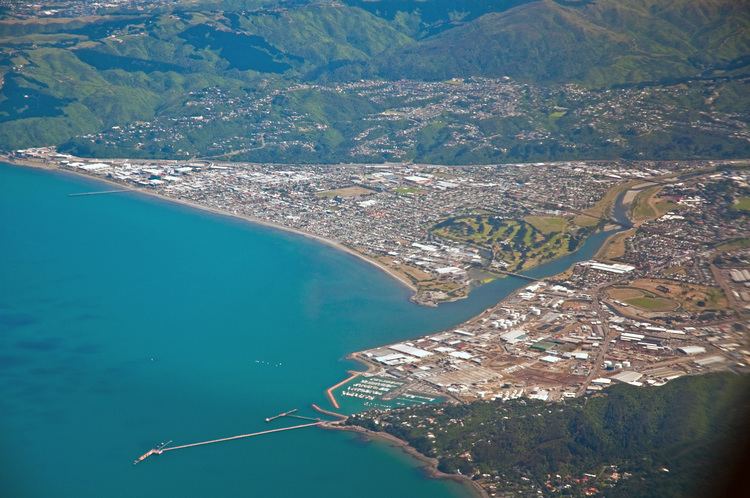Local authority Date established 1840 Postcode(s) 5012 Local time Tuesday 7:06 PM | Electoral ward Harbour Population 6,756 (2013 census) Postal code 5012 | |
 | ||
Train station(s) Petone Railway StationAva Railway Station Weather 16°C, Wind SW at 27 km/h, 94% Humidity Points of interest Sladden Park, Petone Foreshore Playground, Petone Settlers Museum | ||
Petone lower hutt professionals
Petone (/pɛˈtoʊni/, Māori: Pito-one) is a large suburb of Lower Hutt, in the Wellington Region of New Zealand's North Island. It is located at the southern end of the Hutt Valley, on the northern shore of Wellington Harbour. The name, from the Māori Pito-one, means "end of the sand beach".
Contents
- Petone lower hutt professionals
- Map of Petone Lower Hutt New Zealand
- History
- State housing
- Notable features
- Petone Rotary Fair
- Education
- References
Map of Petone, Lower Hutt, New Zealand
Petone was first settled by Europeans in 1840, making it one of the oldest settlements in the Wellington Region. It became a borough in 1888, and merged with Hutt City in 1989.
History
Petone was the first European settlement in the Wellington region and retains many historical buildings and landmarks.
A substantial Maori pa (fortified settlement) was already established at Pito-one close to the beach when the first European settlers arrived in the region. The first European settlers in large numbers arrived on 22 January 1840, on the ship Aurora carrying 25 married couples, 36 single persons and 40 children. The locality was described as, "sandy beach, which is about two miles long ... bounded on either side by wooded hills from 300 to 400 feet in height. It was covered in high forest to within a mile and a half of the beach, when swamps full of flax and a belt of sand hummocks intervened." The Maori from the nearby pa came to meet them, one passenger's diary recording, "the venerable old chief Te Puni ... together with sons and endless relatives and a pa full of natives who were delighted to greet us with 'Kapai-te-Pakeha' and other expressions of greeting". A beach settlement of small wooden houses and tents was established, which was initially called Britannia. The earliest European settlers found life hard. Nevertheless, the settlement grew: the population of "Pito-one and Hutt" in 1845 was given as 649, compared to, "Town of Wellington" of 2,667. In 1850 the Maori pa at Pito-one was described as, "the largest and best fortified within the District of Wellington ... their cultivations of kumara and maize look well and the residents, in point of comfort and wealth, are better off than any of the Port Nicholson natives ... total population 136." There was horse racing at Pito-one Beach on 20 October 1842, attracting a crowd of five or six hundred people from Wellington.
The site for the principal settlement in the area was later designated as Thorndon around the shores of what is now the city of Wellington, New Zealand's capital. Petone gained borough status in 1888.
For much of the 20th century, Petone was a thriving, largely working-class town and the location of several large industrial sites, including two car assembly plants, a meat processing plant, a wool processing plant, a tobacco processing plant, a soap factory and a toothpaste factory. The majority of these closed in the 1970s and 1980s, resulting in gradual economic decline. Petone Borough amalgamated with Lower Hutt as a result of the local government reform in 1989.
The suburb has since enjoyed renewed economic growth, using its early European heritage as a draw for tourists and gaining many cafes and shops.
It is home of the Petone Rugby Club which has been one of the world's leading clubs since 1885.
State housing
Some of New Zealand's first State housing was constructed in Petone in 1906, with some of the original houses remaining in good condition. The local tourist office provides a guide showing where these houses are located.
Notable features
Petone Rotary Fair
The Petone Rotary Fair is a notable local event, held annually since 1992, that draws people from all over the greater Wellington region to Jackson Street, Petone's main thoroughfare, which is closed off to traffic.
The purpose of the fair is not only to raise the profile of Petone and provide an enjoyable day out, but to raise money for charity. The fair consists of various stalls selling everything from plants, artwork, jewellery, CDs & DVDs, cosmetics, food and drink, etc., as well as musicians, carnival rides, and displays from various organisations such as the New Zealand Fire Service.
Education
Petone has three schools
Since Petone College closed in 1998, Hutt Valley High School in central Lower Hutt has been the nearest state secondary school to Petone.
The main campus of the Wellington Institute of Technology (Weltec) is located in Petone.
